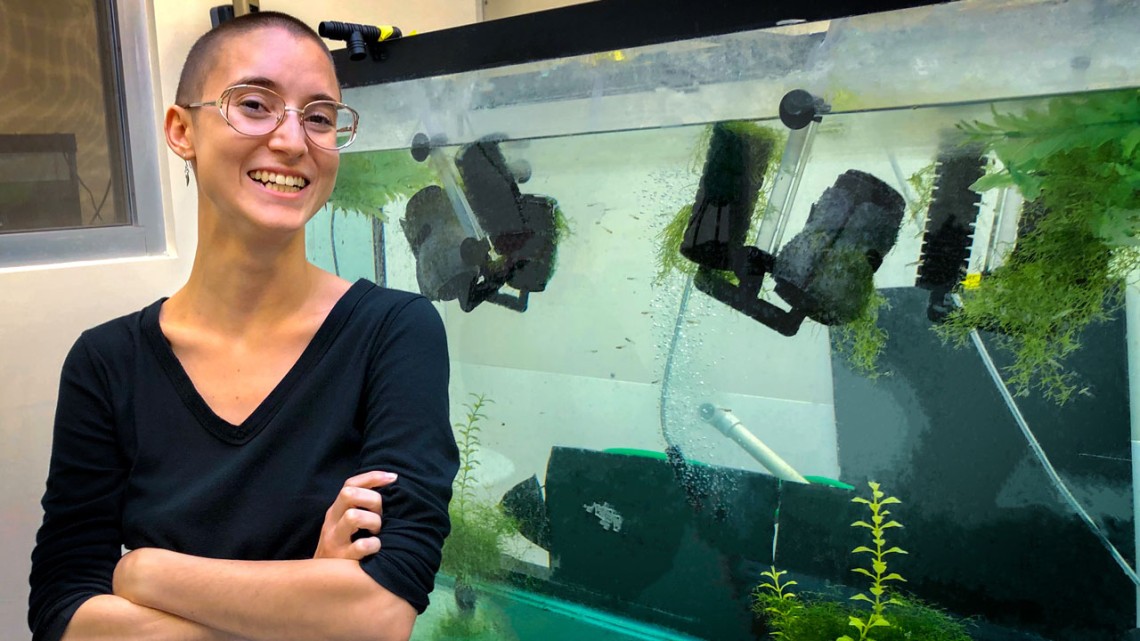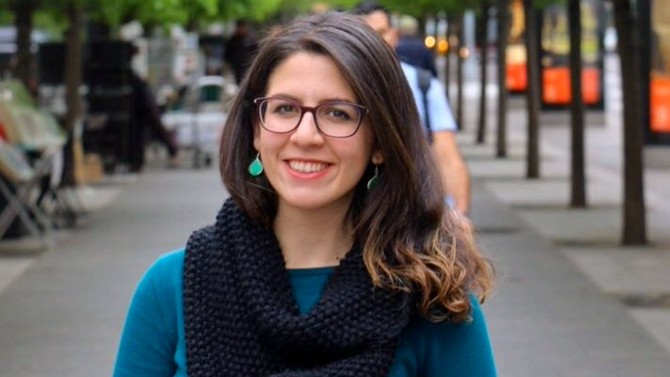
Rose Tatarsky studies the brain of live animals in the context of natural behavior and evolutionary history.
Mong fellowship advances neuroimaging collaboration
By Kate Blackwood
It was late on a Saturday night and snowing hard when doctoral students Rose Tatarsky and Najva Akbari emerged from a basement laboratory in Clark Hall, giddy with a sense of discovery.
As they shared a ride over slippery roads toward their downtown Ithaca homes, they celebrated a major breakthrough in their neurotechnology project, working to image the brain of the transparent fish Danionella dracula. The results of their work are now under review for publication.
Having a map of the entire brain of a living adult vertebrate animal has long been a goal because it will help researchers come to understand the brain of any species. The animal brain, a complex organ, contains many structures with intricate functional relationships. The discovery by Tatarsky, a biologist, and Akbari, an optics expert, could have future implications for human health, setting a path for research into understanding brain function.
“There are a lot of things we can learn from these animals that directly or indirectly allow us to understand how the brain works, maybe how the human brain works,” Akbari said.
Their work together is made possible by the Mong Fellows program in Cornell Neurotech, a joint initiative between the Colleges of Arts and Sciences and Engineering.
“Research of the human brain is really the final frontier of us as a species understanding our own human bodies,” said Stephen Mong ’92, M.Eng. ’93, MBA ’02, who established the Mong Fellows program to empower scientists developing and applying new technologies for understanding neural function. “Researchers have been able to image bones, organs, the heart – but the brain has always been a challenge.”
Based on his deep curiosity about neurological research being done by Cornell scientists including Joseph R. Fetcho, the Dr. and Dorothy Joslovitz Merksamer Professor of Biological Science (A&S), Chris Xu, the IBM Professor of Engineering and Applied Physics (College of Engineering), and Andrew Bass, the Horace White Professor of Neurobiology and Behavior (A&S), Mong’s goal for the fellowship program was to build new technological platforms for scientists to study the brain.
As Mong Junior Fellows, Tatarsky and Akbari did just that, combining their compatible areas of expertise and interest into a powerful research collaboration.
Tatarsky is a fish neurobiologist who studies the brain of live animals in the context of natural behavior and evolutionary history. She joined the Bass lab to study the midshipman fish species: a neuroethological model for looking at sound production and hearing. She then built on this foundation to study the behavior of and create the first known laboratory colony of the fish, Danionella dracula, which is tiny, transparent and has the smallest known vertebrate brain—providing a perfect model to examine with multi-photon microscopy.
Akbari is an optics expert who applies multi-photon microscopy, a particularly powerful tool for in vivo imaging, to biological systems. Her particular focus is the brain, where multi-photon microscopy is a tool for answering neuroscience questions.
The Mong Fellowship gave Akbari and Tatarsky the opportunity to combine their cutting-edge research.
Working with the Xu lab during her doctoral studies, Akbari became adept at using three-photon microscopy, a technique invented by Xu that allows brain imaging in unprecedented detail. One of the side effects, Akbari said, is an additional signal called third harmonic generation (THG) that gives structural information about the brain.
“I was intrigued by this third harmonic generation data because of how beautiful they were, how much information they contained, and how helpful they were in navigating the brain,” Akbari said. “Because these fish are so small, you can see a lot of their brain in a single limited field of view. I wanted to build on that data to make a brain map.”
Tatarsky pursued the promising biological applications for Danionella fish, which are transparent not only as adults, but also through their entire development.
“Using this THG method, we imaged fish at different stages, from three-day-old larvae to fish at different points at their developmental trajectory, which lets us make an anatomical brain map for these different ages,” Tatarsky said. “I see this brain atlas as a useful foundation for people wanting to study the neural development of adult social behavior, for example.”
As they complete their graduate studies, Akbari has taken on a postdoctoral position in the biology department at Stanford University, and Tatarsky plans to become a postdoctoral researcher at the Paris-Saclay Institute of Neuroscience.
Mong believes that a great strength of Cornell lies in the diversity of disciplines. With the Mong Fellows program, he hopes to harness this strength in collaboration.
“Cornell Neurotech is an example of this type of collaborative research to leverage that cross-campus, cross-college expertise in A&S and Engineering,” Mong said. “The Mong fellowship is one piece of it, allowing emerging scientists to participate in that collaboration in a diverse way. They have to be able to talk together; the sooner they start doing that, the better off we all are as members of the Cornell community and of the human race.”
Kate Blackwood is a writer for the College of Arts and Sciences.
Media Contact
Get Cornell news delivered right to your inbox.
Subscribe

